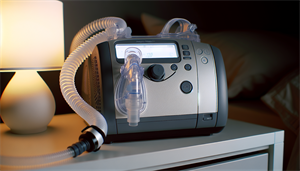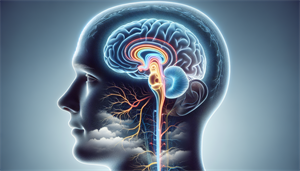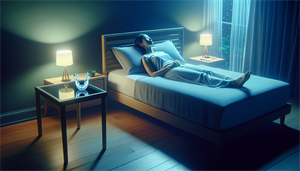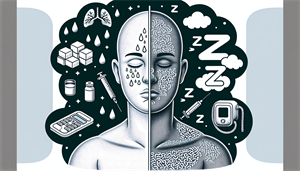Struggling with dizziness can be disconcerting, especially when it seems linked to sleep disturbances like sleep apnea. It’s common to question: can sleep apnea cause dizziness? The answer, simply put, is that sleep apnea, through its interruption of normal breathing, can indeed lead to sensations of dizziness due to fluctuating oxygen levels affecting the brain. This article will delve into the mechanisms by which sleep apnea contributes to these unsettling episodes of lightheadedness without offering excessive detail or making it feel like a sales pitch.
Key Takeaways
-
Sleep apnea can cause dizziness due to hypoxemia (low oxygen levels in the blood), inner ear disruptions, and neurological impacts affecting balance and spatial orientation.
-
Continuous Positive Airway Pressure (CPAP) machines, while effective for treating sleep apnea, can cause dizziness in some patients due to pressure changes in the middle ear. Proper adjustments to the machine and mask can help mitigate this side effect.
-
Comprehensive treatment of dizziness in sleep apnea patients may involve a multifaceted approach including CPAP therapy, alternative treatments (like positional therapies and oral appliances), comprehensive care plans, and addressing comorbid conditions.
Unraveling the Mystery: How Sleep Apnea Influences Dizziness

Sleep apnea, including central sleep apnea, is a form of sleep disordered breathing that manifests as recurring disruptions in breathing during sleep, resulting in diminished oxygen supply to the brain. Often, people with sleep apnea experience dizziness first thing in the morning. This disorientation, characterized by a sensation of lightheadedness, can complicate the transition from a supine to an upright position for patients.
Various physiological mechanisms underpin the association between sleep apnea and dizziness. The primary culprits include hypoxemia, disturbances in the inner ear, and an impact on neurological functions. Comprehending these elements facilitates the development of effective solutions for treating sleep apnea and the related dizziness.
Hypoxemia and Disorientation
Hypoxemia, a state of low oxygen levels in the blood, is a common occurrence in untreated sleep apnea. The symptoms associated with hypoxemia can range from:
-
severe fatigue
-
daytime drowsiness
-
cognitive impairment
-
visual disturbances
One of the most serious symptoms, however, is a feeling of disorientation, which can manifest as dizziness.
The precise process through which hypoxemia triggers disorientation and dizziness is the insufficient oxygen provision to the brain, which hampers its regular operation. This condition is particularly evident in individuals with sleep apnea, where chronic intermittent hypoxia and molecular-level alterations are common. Treating sleep apnea can help alleviate these symptoms and improve patients’ quality of life.
Inner Ear Disruptions
Inner ear disruption also contributes to dizziness in patients with sleep apnea. The inner ear plays a crucial role in maintaining balance, and any disruptions to its function can lead to dizziness and vertigo. Sleep apnea can impact the inner ear through hypoxia-induced oxidative stress, inflammation, and alterations in blood flow.
The underlying mechanism here involves the fluctuations in air pressure that occur during sleep apnea events. These pressure changes can affect the middle ear and disrupt the inner ear’s function, potentially leading to symptoms of dizziness. Patients may experience dizziness and vertigo as a result of impaired blood flow to the inner ear due to these disruptions.
Neurological Impact
Sleep apnea’s neurological impact further adds to the incidence of dizziness. During an apnea event, changes in cerebral perfusion, cerebral desaturation, and cerebral hemodynamics take place. This alteration in neuronal function may cause disorientation and dizziness, affecting the brain’s balance and spatial orientation systems.
The intermittent hypoxia resulting from sleep apnea can lead to adverse effects on brain function, such as compromised memory and attention, as well as neuronal impairment and dysfunction within the central nervous system. Addressing sleep apnea through various therapeutic interventions can help mitigate these neurological impacts and alleviate dizziness.
The Role of CPAP: Treatment and Side Effects

Continuous Positive Airway Pressure (CPAP) machines are among the most prevalent treatment options for sleep apnea. These devices deliver pressurized air through a mask and tube, helping to maintain open airways and prevent interruptions in breathing. However, while CPAP therapy is highly effective in treating sleep apnea, it can also be a double-edged sword.
Dizziness, believed to stem from air pressure changes in the middle ear due to the transference of positive air pressure from the CPAP machine, is experienced by some patients using CPAP machines. This side effect, while concerning, can be managed with appropriate interventions, as we’ll discuss next.
CPAP as a Double-Edged Sword
CPAP machines are both a boon and a bane for sleep apnea patients. On the one hand, they are effective in relieving symptoms of sleep apnea by keeping the airways open and preventing apnea episodes. On the other hand, they can lead to dizziness due to pressure changes in the middle ear.
The initial dizziness or vertigo experienced by some CPAP wearers may be due to the body’s adaptation to the new pressure. High pressure settings, mask fit issues, and changes in blood pressure or oxygen levels can all contribute to this side effect. While this might sound daunting, there are ways to address these concerns and make CPAP therapy more comfortable for patients.
Addressing CPAP Concerns
Dealing with CPAP concerns involves making necessary adjustments to the machine settings and ensuring a proper mask fit. Accurately adjusting the settings on a CPAP machine is crucial to ensure the effectiveness and comfort of the therapy for the patient. Proper adjustment can help alleviate potential side effects, such as dizziness, which may arise from incorrect pressure settings.
Patients can modify the following settings to enhance their CPAP therapy experience:
-
Humidifier settings to address dryness
-
Pressure settings in case of discomfort
-
Utilize features such as pressure relief technology to facilitate exhalation against the incoming air
Ensuring a proper mask fit is essential for the effectiveness of CPAP therapy as it prevents air leaks that can result in suboptimal treatment and the development of side effects.
Regular cleaning of the mask and timely replacement of worn parts can contribute to maintaining a proper fit over time.
Beyond Sleep Apnea: Other Factors Contributing to Dizziness

Although sleep apnea significantly contributes to dizziness, it is not the sole factor involved in this symptom. Comorbid conditions and vascular implications, for instance, can also contribute to dizziness in sleep apnea patients. Understanding these additional factors can help provide a more comprehensive approach to managing dizziness in sleep apnea patients.
Common comorbid conditions that can cause dizziness in patients with sleep apnea include Menière’s disease and vestibular migraine. Meanwhile, vascular implications, such as cerebral small vessel disease, can also contribute to the symptom. Let’s delve deeper into these additional factors.
Comorbid Conditions
Vestibular migraine and Menière’s disease, which are comorbid conditions, may induce dizziness in individuals with sleep apnea. A vestibular migraine leads to recurrent episodes of dizziness or vertigo in individuals with a migraine history, while Menière’s disease can result in periods of dizziness and hearing impairment.
These conditions are significantly more common in sleep apnea patients compared to the general population. Therefore, properly diagnosing and managing these conditions is crucial in addressing dizziness in sleep apnea patients.
Vascular Implications
Vascular implications, such as cerebral small vessel disease, play a role in dizziness experienced by sleep apnea patients. Cerebral small vessel disease, a type of cerebrovascular disorders, is associated with dizziness, and patients with unexplained dizziness are found to have a higher likelihood of having this type of small vessel disease. Moreover, clinical cardiovascular consequences can be a concern for sleep apnea patients, as they may be related to the vascular issues mentioned.
The heightened vascular risks linked to sleep apnea significantly elevate the risk of migraines, Menière’s disease, and sudden sensorineural hearing loss, all of which can result in dizziness. Therefore, addressing these vascular implications is an essential part of managing dizziness in sleep apnea patients.
Clinical Evidence: Studies Linking Sleep Apnea and Dizziness

Investigative studies are instrumental in elucidating the connection between sleep apnea and dizziness. Numerous research findings have drawn links between sleep apnea and dizziness, emphasizing the part played by REM-related obstructive sleep apnea and certain risk factors in this association.
These findings provide a scientific backbone to our understanding of how sleep apnea influences dizziness and help guide effective treatment strategies. Let’s delve into some of these research highlights and take a closer look at the risk factors identified in these studies.
Research Highlights
Numerous studies have shed light on the connection between sleep apnea and dizziness. For instance, research has shown a correlation between sleep apnea and vertigo, with individuals experiencing sleep apnea having a higher prevalence of REM-related events and a 1.36 times increased risk of tinnitus.
Moreover, studies have indicated that obstructive sleep apnea can worsen vestibular symptoms in patients affected by conditions such as vestibular migraine and Menière’s disease. This body of research underscores the complex interplay between sleep apnea and dizziness and provides a scientific basis for developing effective treatment strategies.
A Closer Look at Risk Factors
Understanding the risk factors for dizziness in sleep apnea patients can help guide treatment decisions. For instance, research has found that being female, exhibiting symptoms of vertigo and tinnitus, and having an Epworth Sleepiness Scale score of less than 10 are potential risk factors for dizziness in sleep apnea patients.
Increased risk of dizziness in female sleep apnea patients may be attributed to higher rates of sleep disturbance, emotional stress, and anxiety. Furthermore, excessive daytime sleepiness, as measured by the Epworth Sleepiness Scale, is associated with sleep apnea and could potentially contribute to the occurrence of dizziness.
Strategies for Treating Dizziness in Sleep Apnea Patients

Treating dizziness in sleep apnea patients requires a multifaceted approach that goes beyond merely addressing the sleep disorder itself. Comprehensive care plans and alternative therapies can play a crucial role in managing dizziness symptoms in these patients.
These remedial strategies encompass a wide array of interventions, including:
-
Conventional CPAP therapy
-
Surgical measures
-
Lifestyle alterations
-
Management of comorbid conditions
Let’s explore some of these strategies in more detail.
Non-CPAP Therapies
While CPAP therapy is the most common treatment for sleep apnea, it may not be suitable for all patients, especially those experiencing dizziness due to pressure changes. In such cases, alternative therapies can be beneficial.
These alternatives include positional therapies, oral appliances, lifestyle modifications, and surgical interventions, among others. Positional therapies involve the use of specific sleeping positions, such as elevating the head by a minimum of 45 degrees, to alleviate dizziness and enhance symptoms. Oral appliances have also demonstrated considerable effectiveness in treating sleep apnea and alleviating dizziness.
Comprehensive Care
Comprehensive care for sleep apnea patients who experience dizziness involves a patient-centered approach, addressing patient-specific needs to inform treatment decisions. Such care plans may include lifestyle modifications like weight loss and exercise, avoidance of supine sleep positions, and refraining from alcohol and sedatives.
Additionally, addressing comorbid conditions like Ménière’s disease, vestibular migraine, and benign paroxysmal positional vertigo is vital to managing dizziness in these patients. By providing comprehensive care, healthcare providers can effectively manage and control symptoms, enhancing patient outcomes.
Navigating Diagnosis and Management
Accurate diagnosis and efficient management of dizziness in sleep apnea patients are key to successful treatment. This process involves the use of diagnostic tools and tests to identify the underlying causes of dizziness, followed by the creation of personalized treatment plans based on the identified causes.
The diagnostic tools and tests used can range from videonystagmography to vestibular-evoked myogenic potentials, each providing valuable insights into the causes of dizziness. Armed with this information, healthcare providers can then develop personalized treatment plans to manage dizziness effectively.
Diagnostic Tools and Tests
A host of diagnostic apparatus and tests are vital in pinpointing the cause of dizziness in sleep apnea patients. For instance, videonystagmography (VNG) is used to assess the functionality of the vestibular system and detect any irregularities in the inner ear or central nervous system that could be contributing to dizziness.
Similarly, vestibular-evoked myogenic potentials (VEMPs) can help identify vestibular system lesions in sleep apnea patients, encompassing the vestibular nerve and central vestibular pathways. A study evaluated clinical descriptions of these patients and found that other tests, such as video head impulse testing and audiometry tests, can also provide valuable insights into the causes of dizziness in these patients.
Personalized Treatment Plans
Upon identifying the causes of dizziness in sleep apnea patients, healthcare providers can formulate customized treatment strategies. These plans may include a combination of CPAP therapy, non-CPAP therapies, and interventions to address comorbid sleep disorders and other conditions.
Personalized treatment plans have demonstrated the ability to alleviate symptoms and are cost-effective. Whether it involves selecting the right CPAP machine settings or choosing an alternative therapy, these plans are tailored to the specific needs of the patient, ensuring a comprehensive, patient-centered approach to managing dizziness in sleep apnea patients.
Summary
This exploration into the connection between sleep apnea and dizziness reveals a complex interplay of physiological mechanisms, treatment options, and research studies. From the effects of hypoxemia and inner ear disruptions to the benefits and drawbacks of CPAP therapy, the journey to understanding and managing dizziness in sleep apnea patients is multifaceted. As science continues to unravel this intriguing link, it’s crucial for patients and healthcare providers to stay informed and proactive. Remember, managing sleep apnea is not just about improving sleep quality; it’s about enhancing overall health and well-being.
Frequently Asked Questions
What does sleep apnea dizziness feel like?
People with sleep apnea and dizziness may experience disorientation upon waking up in the morning and may feel lightheaded, nauseous, or like they are about to faint during the day. These symptoms can be attributed to compromised blood oxygenation due to sleep apnea.
Can sleep apnea cause off balance?
Yes, sleep apnea can cause dizziness and balance issues due to airflow interruptions affecting ear pressure and cerebral ischemia affecting blood supply to the brain.
What are 3 symptoms of sleep apnea?
Common symptoms of sleep apnea include loud snoring, gasping for air during sleep, and excessive daytime sleepiness. It's important to recognize these symptoms and seek medical attention if you experience them.
What is the role of CPAP therapy in treating sleep apnea and how can it cause dizziness?
CPAP therapy helps maintain open airways and prevent breathing interruptions, but it can cause dizziness in some patients due to pressure changes in the middle ear.
What are the alternative therapies for sleep apnea besides CPAP?
Besides CPAP, alternative therapies for sleep apnea include positional therapies, oral appliances, lifestyle modifications, and surgical interventions. These options can provide more choices for managing sleep apnea effectively.


